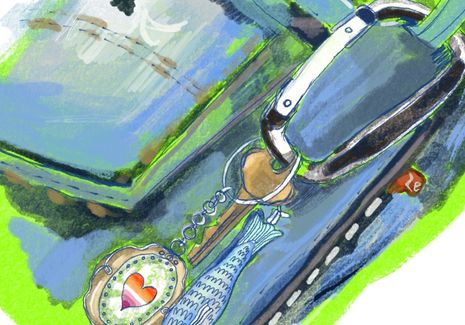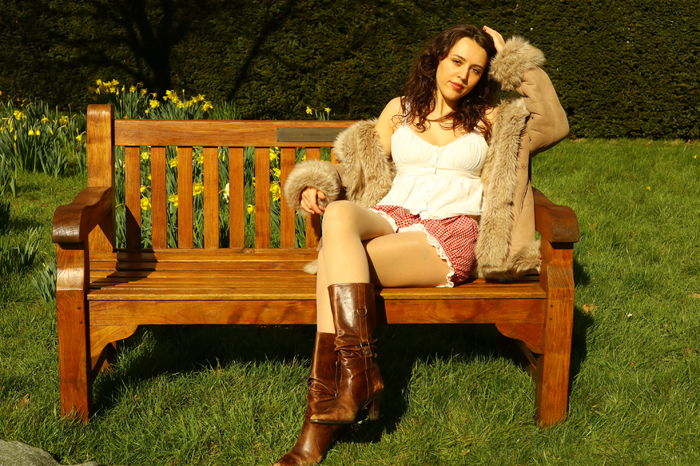Of course you have blue hair and pronouns!
Grace MacLean examines symbolism in fashion in the current climate

I believe we are culturally taught, hopefully, from a young age that we shouldn’t make distinct judgements about people based on their appearances. But what if one wants to signal something about oneself through their appearance?
Noticeably, if you are LGBTQ+ you have likely heard of fashion stereotypes attached to particulars of the community. Carabiners, a left ear piercing, and (at one point) cuffed trousers were all emblems of queerness. There is nothing inherent about the invention of the carabiner that is lesbian-coded. A bricklayer in a small town in England or Wales does not realise that he is dressed the same way as a lesbian in Brooklyn, in Carhartt jackets, cargo pants, carabiner with his keys on, and simple chain jewellery. For example, when someone’s dad wears his jorts, his polo neck and his big manly watch communicate conformity, but when Billie Eilish puts on the exact same outfit she receives a different perception.
“…even small, impermanent, style choices can be read as nuanced political declarations”
These symbols of self-identification have in history been brilliant indicators of solidarity and unity in marginalised groups. Despite the unity which these symbols can create, there are harmful stereotypes that can develop from this. A personal standout would be the ‘blue hair and pronouns’ or the ‘blue haired liberal’ trope. This symbolic image was an intended attack through the association of alternative fashion choices to a political standpoint, and was first posted as a comment on TikTok: “Of course you have blue hair and pronouns.” This comment was then screenshotted and posted to Twitter in 2021, and since then has circled around alternative and queer internet spaces as a self-effacing meme. Last summer, I dyed my hair orangey-pink just because I liked it. Still, someone asked if it reflected how I’d vote in July’s election. I think this was very demonstrative of “blue hair and pronouns” and how even small, impermanent, style choices can be read as nuanced political declarations.
Recently, discourse began about being able to correlate somebody’s screen time to their fashion choices, and ideas of “online” vs in person fashion senses developed. The iconic alternative makeup trends associated with TikTok in 2020 worked at the time because the bold, over-the-top, and colourful looks were contained within screens: it was rare to see somebody in person wearing the same intense makeup looks and outfits that trended at the time because- we weren’t seeing each other. These trends died out, and it is rare I see the heavy blush and intense eyeliner, bunny rabbit hats, and frog paraphernalia on anybody my own age anymore… maybe I miss it. But at the time, these were our teenage symbols of rebellion, all within the safety of our own lockdown bedrooms.
“Serve your families, ladies, and look good whilst doing it!”
More alarming than a 14 year old wearing too much liquid eyeliner to symbolise their edgy vibes, however, is the fashion trends and symbols attached to the recent sky-rocket in tradwife content online. Creators such as Nara Smith or Hannah Neeleman document and glorify their domestic-centric lifestyles: wearing full Hollywood-style glam makeup and a cottage-core-esque maxi dress. Their clothing is impractical for their domestic, and even laborious, tasks which they demonstrate. Why is Nara Smith wearing a Met-Gala tier outfit whilst making Oreos from scratch? In what world do those puffy sleeves not irritate you when you are churning your own butter? These Marilyn Monroe inspired looks, with polka patterns and florals, are creeping in under the eerie idealisation of female subservience. Conservative looks cannot just represent domestic bliss, where you can make a meal from scratch without a bead of sweat destroying your perfectly curled hair, and where your manicures never chip, but they carry uncomfortable undertones of the rising and prevalent right-wing politics and ideals which can, and do, damage women’s autonomies. It feels very 1950s advert: serve your families, ladies, and look good whilst doing it!
Whilst the internet is largely responsible for much of the distribution and outreach of symbolic fashion items, the keffiyeh has long preceded internet culture as a symbol of resistance. Keffiyeh’s have recently seen an increase in purchases, as they have become symbolic of solidarity with the current war in Palestine. These purchases are not merely in line with trends, they are not a pair of ugg boots, but instead stand for and represent a moral and political allyship. The keffiyeh has been a symbol of resistance for almost a century, beginning in the 1930s as an emblem of resistance against British colonial rule. Furthermore, under Israeli occupation, only one authentic keffiyeh producer remains, and they depend on their resources passing through Israeli border controls and checkpoints which make the production a logistical grievance. With censorship on the rise, symbols like these in fashion, like many of the LGBTQ+ indicators, have been and continue to be vital emblems of solidarity against oppression.
Maybe fashion really is our most chaotic love language: part rebellion, part demonstration of our practicality, part accidental political manifesto. Dress with intention, or don’t – either way, someone’s definitely making assumptions.
 Features / Should I stay or should I go? Cambridge students and alumni reflect on how their memories stay with them15 December 2025
Features / Should I stay or should I go? Cambridge students and alumni reflect on how their memories stay with them15 December 2025 News / Cambridge study finds students learn better with notes than AI13 December 2025
News / Cambridge study finds students learn better with notes than AI13 December 2025 Comment / The magic of an eight-week term15 December 2025
Comment / The magic of an eight-week term15 December 2025 News / News In Brief: Michaelmas marriages, monogamous mammals, and messaging manipulation15 December 2025
News / News In Brief: Michaelmas marriages, monogamous mammals, and messaging manipulation15 December 2025 News / Uni Scout and Guide Club affirms trans inclusion 12 December 2025
News / Uni Scout and Guide Club affirms trans inclusion 12 December 2025










